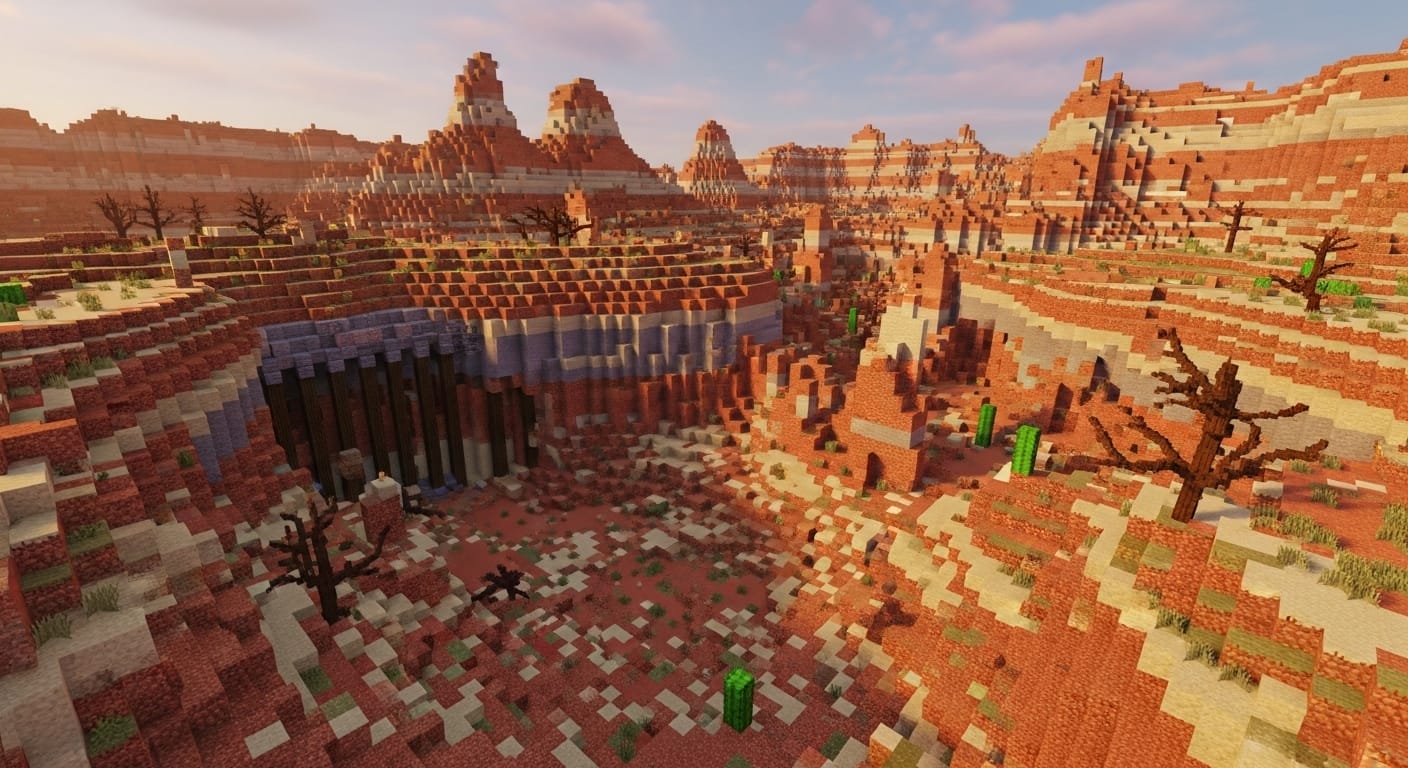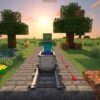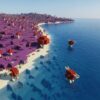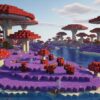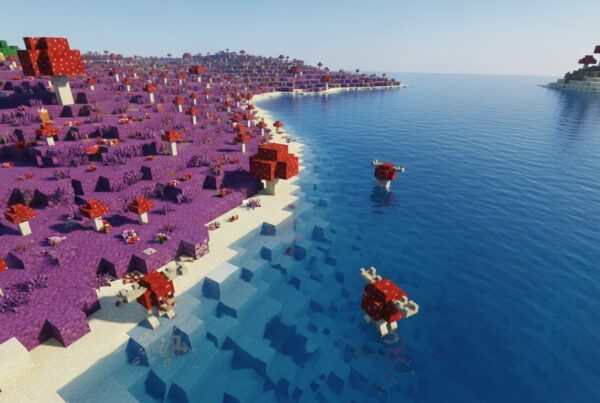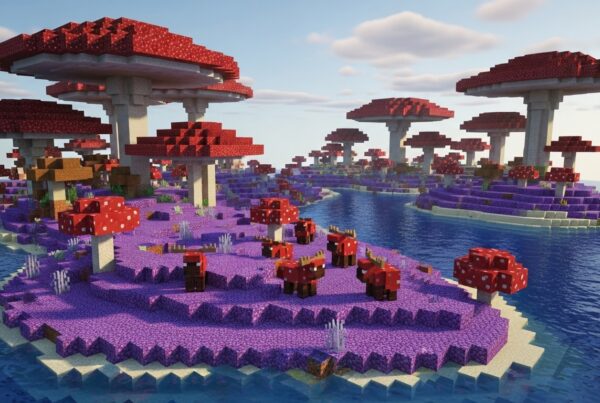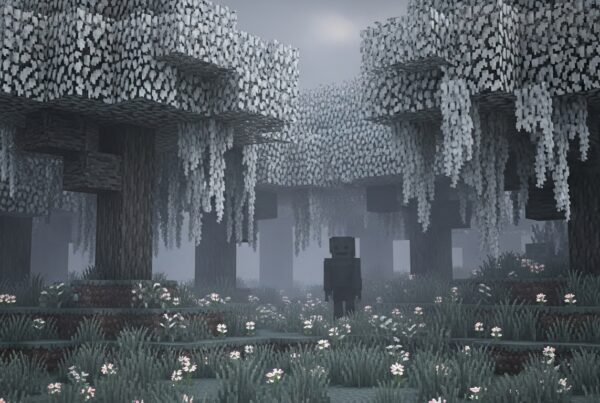“A land of color, canyons, and hidden riches — the Badlands are among Minecraft’s rarest and most visually stunning biomes.”
Overview
The Badlands biome, previously known as the Mesa, is a warm, arid biome in Minecraft characterized by its vivid, layered terrain of terracotta, red sand, and stone. It is one of the most colorful and striking regions in the Overworld, featuring steep plateaus, cliffs, and deep canyons resembling the American Southwest.
No rain ever falls in the Badlands, and vegetation is sparse, making it a challenging location for survival. However, it is rich in terracotta and gold ore, making it valuable for builders and miners alike.
Introduced in Minecraft 1.7 (The Update that Changed the World) and renamed from Mesa to Badlands in Minecraft 1.13 (The Update Aquatic), this biome remains one of the rarest and most unique environments in the game.
Climate
| Property | Value |
|---|---|
| Temperature | 2.0 |
| Downfall | 0.0 |
| Precipitation | None (no rain or snow) |
| Grass Color | #90814D |
| Foliage Color | #9E814D |
| Water Color | #3F76E4 |
The Badlands are one of the driest and hottest biomes, sharing similar climate conditions with deserts. Water and vegetation are extremely limited.
Generation and Variants
The Badlands biome generates in warm, dry regions of the Overworld, often bordering deserts or savannas. It features distinctive layered terrain where different colors of terracotta are stacked in natural bands.
Terracotta Layers
- Up to 192 layers of terracotta generate, with a “noise” function causing vertical variation of up to ±7 blocks.
- The most common terracotta colors are orange, white, yellow, red, brown, and light gray.
- Red sand covers the surface instead of grass or dirt.
Variants
- Badlands (Standard):
The base biome, dominated by red sand, terracotta, and sparse vegetation such as dead bushes and cacti. - Wooded Badlands:
Found at higher elevations, featuring patches of grass blocks, coarse dirt, and occasional oak trees.
Typically appears above Y = 103. - Eroded Badlands:
Distinguished by tall, spire-like formations called hoodoos, created by natural erosion.
Inspired by Bryce Canyon National Park (Utah, USA), this sub-biome is one of Minecraft’s most scenic.
Blocks and Terrain Features
- Terracotta (all natural colors) — main block type forming horizontal strata.
- Red Sand — covers the surface.
- Stone and Gold Ore — abundant below the terracotta layers.
- Vegetation: limited to dead bushes and cacti.
- Clay and gravel sometimes generate near rivers and edges.
The Badlands’ vivid layers make it a favorite location for builders seeking natural color variation.
Mobs
Java Edition
- Passive mobs: Do not spawn naturally in the standard Badlands.
- Hostile mobs: Spawn as usual in dark areas or at night (Zombies, Skeletons, Spiders, Creepers).
- Bats spawn in caves.
Bedrock Edition
- Some passive mobs (like rabbits) can spawn occasionally in Wooded or Eroded Badlands variants.
Structures
| Structure | Details |
|---|---|
| Mineshafts | Extremely common; often exposed on the surface or embedded in canyon walls. Use dark oak planks and fences instead of oak. |
| Fossils | Rarely found underground. |
| Villages | Can appear near Wooded Badlands when adjacent to compatible terrain (e.g., savanna or desert). |
Additionally, gold ore generates more frequently here than in any other biome — up to Y = 255 in Java Edition.
Resources and Uses
- Terracotta: Abundant and available in multiple natural colors. Can be smelted into glazed terracotta.
- Gold Ore: Exceptionally common; ideal for mining operations and powered rail crafting.
- Red Sand: Used to craft red sandstone, a decorative building block.
- Dead Bushes: Drop sticks when broken, providing limited early resources.
The Badlands are a builder’s paradise thanks to their palette and unique terrain.
Gameplay Tips
- Survival: Bring food and wood — both are scarce. Nearby deserts or savannas may provide easier access to villages and crops.
- Mining: Focus on gold ore veins near the surface; exposed mineshafts are excellent for early loot.
- Building: The natural color layering pairs beautifully with sandstone or terracotta builds.
- Exploration: Watch for steep cliffs and erosion spires — fall damage is a frequent risk.
History
| Version | Changes |
|---|---|
| 1.7 (2013) | Introduced as Mesa. |
| 1.13 (2018) | Renamed Mesa → Badlands. |
| 1.18 (2021) | World generation updated — increased terracotta layers and noise variation. |
| 1.19+ | Improved ore distribution; gold ore now spawns up to Y = 255 in Java Edition. |
Trivia
- Badlands biomes are among the rarest in Minecraft.
- The biome was inspired by real-world badlands formations in the southwestern United States.
- Mineshafts here are unique for using dark oak wood, unlike any other biome.
- It never rains or snows in the Badlands.
- The biome’s original name “Mesa” referred to its flat-topped plateaus.
Gallery
- Standard Badlands landscape.
- Eroded Badlands spires.
- Wooded Badlands plateau.
- Exposed surface mineshaft.
- Terracotta strata cross-section.
See Also
- [Desert Biome]
- [Savanna Biome]
- [Terracotta]
- [Glazed Terracotta]
- [Red Sandstone]
- [Mineshaft]
- [Biome Variants]
